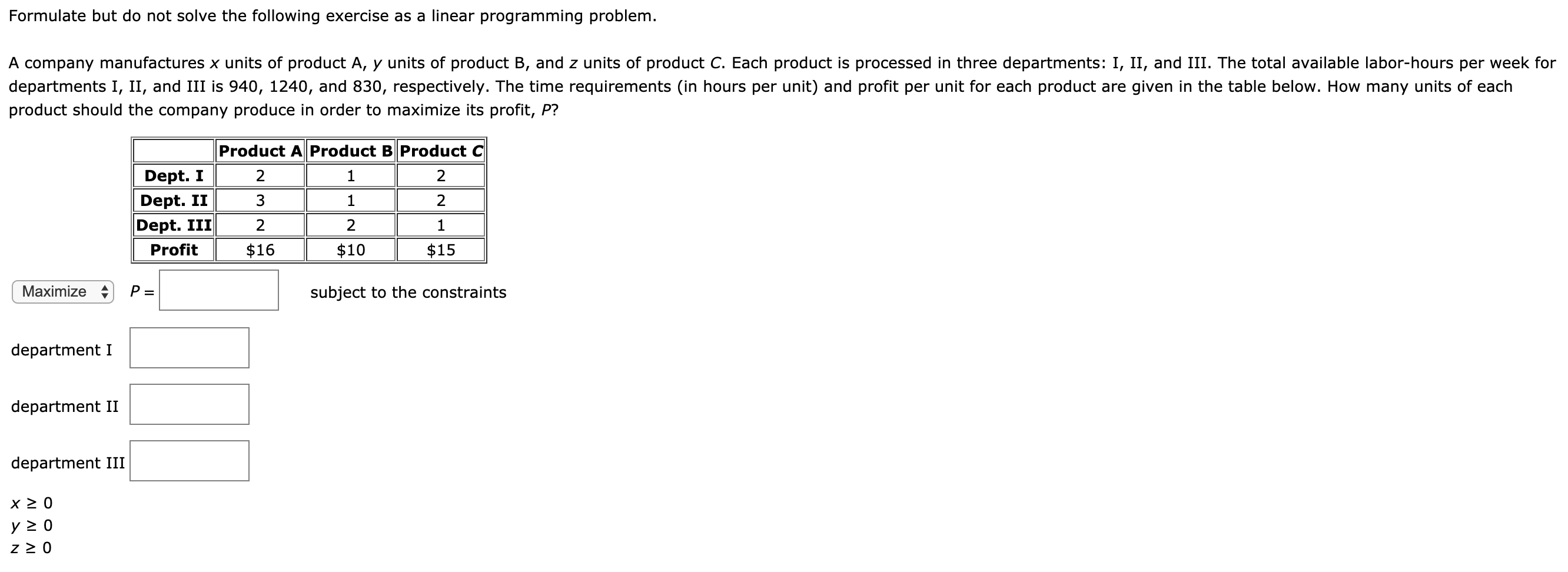Formulate but do not solve the following exercise as a linear programming problem. A company manufactures x units of product A, y units of product B, and z units of product C. Each product is processed in three departments: I, II, and III. The total available labor-hours per week for departments I, II, and III is 940, 1240, and 830, respectively. The time requirements (in hours per unit) and profit per unit for each product are given in the table below. How many units of each product should the company produce in order to maximize its profit, P? Product AProduct B Product C Dept. I Dept. II Dept. III 2 2 Profit $16 $10 $15 Maximize subject to the constraints department I department II department III
Formulate but do not solve the following exercise as a linear programming problem. A company manufactures x units of product A, y units of product B, and z units of product C. Each product is processed in three departments: I, II, and III. The total available labor-hours per week for departments I, II, and III is 940, 1240, and 830, respectively. The time requirements (in hours per unit) and profit per unit for each product are given in the table below. How many units of each product should the company produce in order to maximize its profit, P? Product AProduct B Product C Dept. I Dept. II Dept. III 2 2 Profit $16 $10 $15 Maximize subject to the constraints department I department II department III
Calculus: Early Transcendentals
8th Edition
ISBN:9781285741550
Author:James Stewart
Publisher:James Stewart
Chapter1: Functions And Models
Section: Chapter Questions
Problem 1RCC: (a) What is a function? What are its domain and range? (b) What is the graph of a function? (c) How...
Related questions
Question

Transcribed Image Text:Formulate but do not solve the following exercise as a linear programming problem.
A company manufactures x units of product A, y units of product B, and z units of product C. Each product is processed in three departments: I, II, and III. The total available labor-hours per week for
departments I, II, and III is 940, 1240, and 830, respectively. The time requirements (in hours per unit) and profit per unit for each product are given in the table below. How many units of each
product should the company produce in order to maximize its profit, P?
Product AProduct B Product C
Dept. I
Dept. II
Dept. III
2
2
Profit
$16
$10
$15
Maximize
subject to the constraints
department I
department II
department III
Expert Solution
This question has been solved!
Explore an expertly crafted, step-by-step solution for a thorough understanding of key concepts.
This is a popular solution!
Trending now
This is a popular solution!
Step by step
Solved in 2 steps

Recommended textbooks for you

Calculus: Early Transcendentals
Calculus
ISBN:
9781285741550
Author:
James Stewart
Publisher:
Cengage Learning

Thomas' Calculus (14th Edition)
Calculus
ISBN:
9780134438986
Author:
Joel R. Hass, Christopher E. Heil, Maurice D. Weir
Publisher:
PEARSON

Calculus: Early Transcendentals (3rd Edition)
Calculus
ISBN:
9780134763644
Author:
William L. Briggs, Lyle Cochran, Bernard Gillett, Eric Schulz
Publisher:
PEARSON

Calculus: Early Transcendentals
Calculus
ISBN:
9781285741550
Author:
James Stewart
Publisher:
Cengage Learning

Thomas' Calculus (14th Edition)
Calculus
ISBN:
9780134438986
Author:
Joel R. Hass, Christopher E. Heil, Maurice D. Weir
Publisher:
PEARSON

Calculus: Early Transcendentals (3rd Edition)
Calculus
ISBN:
9780134763644
Author:
William L. Briggs, Lyle Cochran, Bernard Gillett, Eric Schulz
Publisher:
PEARSON

Calculus: Early Transcendentals
Calculus
ISBN:
9781319050740
Author:
Jon Rogawski, Colin Adams, Robert Franzosa
Publisher:
W. H. Freeman


Calculus: Early Transcendental Functions
Calculus
ISBN:
9781337552516
Author:
Ron Larson, Bruce H. Edwards
Publisher:
Cengage Learning